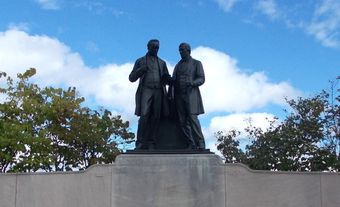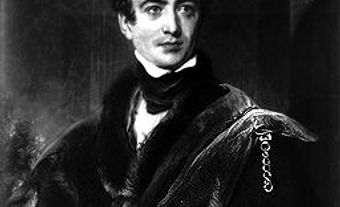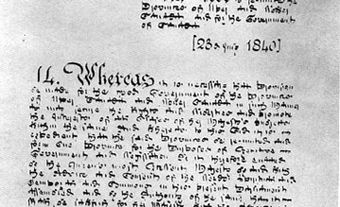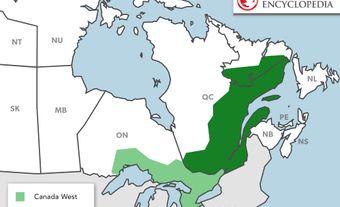Representation by population (or “rep by pop”) is a political system. It is when seats in a legislature are assigned based on population. This upholds a basic idea of democracy that all votes should be counted equally. Rep by pop was a deeply divisive issue in the Province of Canada (1841–67). It became an important factor in Confederation.
This article is a plain-language summary of Rep by Pop. If you would like to read about this topic in more depth, please see our full-length entry: Rep by Pop.
![The province of Canada [cartographic material] The province of Canada [cartographic material]](https://d3d0lqu00lnqvz.cloudfront.net/media/media/bf6a8447-8306-4749-bb63-2f6129eb20a6.jpg)
Province of Canada
Rep by Pop first came up as an issue in the debate over whether to unite Upper and Lower Canada. ( See Durham Report.) The Act of Union merged Lower Canada (now called Canada East) and Upper Canada (now called Canada West) into the Province of Canada. East and West both had the same number of seats in the legislature. But Canada East had 59 per cent of the population. Canada West only had 41 per cent. This meant that the West had more representation than the East.
Giving the two Canadas the same number of seats was called “sectional equality.” The mostly English-speaking and Protestant population of Canada West liked it. They felt they needed a safeguard against the bigger Canada East. They had long-held feelings of mistrust and prejudice toward the largely Roman Catholic, French-speaking people in Canada East. They thought that Canada East had a Roman Catholic “priestocracy” who had too much influence. The goal was to assimilate French Canadians to English Canadian culture and norms.
Sectional equality drew protests from politicians in Canada East. They argued that it left them powerless in the new legislature. They also hated the attempt to assimilate them. They were the first to demand Rep by Pop.

Francis Hincks and George Brown
A census was held in 1851. It showed that immigration, mainly from Britain and Ireland, had given Canada West a bigger population than Canada East. The situation was now reversed. It was now the French Canadians who were over-represented. A growing number of English Canadians saw this as unfair. But Canada East still feared domination by Canada West, since most immigrants preferred to go there.
French Canadians in Canada East now wished to keep sectional equality. They had a spokesman in Francis Hincks. He was a moderate Reformer. He thought that Anglo-French political relationships required trust. This had to be based on equality. To give either side more influence could destroy trust in the Union itself.
George Brown, from Canada West, was also a Reformer. He saw Hincks as a sellout for supporting sectional equality. Brown became a supporter of Rep by Pop as Canada West grew in population and prosperity. He felt that most of Canada West’s voters shared his view. He disliked what he called “French domination” of the Province of Canada.
The debate over Rep by Pop and sectional equality went on for 10 years. It threatened the Union. Some reformers were more radical. Brown called them “Clear Grits.” They were ready to end the Union in their quest for Rep by Pop. But Brown wanted the Union remade, not destroyed.

Macdonald and Cartier
George-Étienne Cartier was leader of the conservative Parti bleu in Canada East. He opposed Rep by Pop. In 1864, Conservatives in Canada West under John A. Macdonald formed a great coalition with Cartier. The coalition was able to hold onto power in the legislature. They did so with the help of moderate Reformers such as Hincks. But it soon became clear to Macdonald, Cartier, Brown and others that a compromise between the two sides would be needed if they were to achieve their common goal of Confederation.
Rep by Pop and Confederation
Several conferences were held to discuss Confederation. (See Quebec Conference; Charlottetown Conference; London Conference.) Delegates from the Province of Canada, PEI, Newfoundland, New Brunswick and Nova Scotia went to them. Rep by Pop was once again a hot topic. The much smaller Maritimes knew that any federal assembly would have Rep by Pop. But they feared that they would have little influence in the new government. So, they asked for some form of balance.
The delegates reached a solution. The federal Parliament would have two houses. The lower house, the House of Commons, would have elected members. They would represent their provinces based on population. Ontario would get 82 seats. Quebec would get 65. Nova Scotia would get 9. And New Brunswick would get 15. The upper house, the Senate, would consist of 72 appointed members. Each of the three regions — Ontario, Quebec and the Maritimes — would get 24 senate seats. The number of seats given to each province would be updated after each 10-year census. (See Redistribution of Federal Electoral Districts.) This was laid out in section 51 of the British North America Act (now called the Constitution Act, 1867).
See also Responsible Government (Plain-Language Summary); Durham Report (Plain-Language Summary); Act of Union (Plain-Language Summary); Province of Canada (Plain-Language Summary); Great Coalition of 1864 (Plain-Language Summary).

 Share on Facebook
Share on Facebook Share on X
Share on X Share by Email
Share by Email Share on Google Classroom
Share on Google Classroom





![The province of Canada [cartographic material]](https://d14fiu1i7ba797.cloudfront.net/340x207/media/media/bf6a8447-8306-4749-bb63-2f6129eb20a6.jpg)



